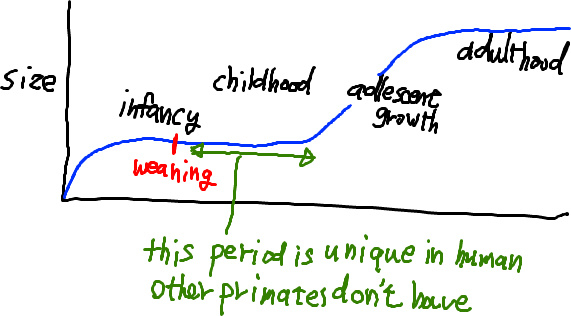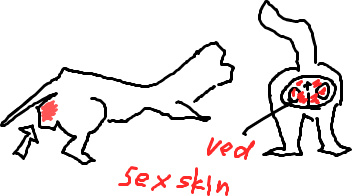霊長類行動学4. 生活環(Life history)
Life history(生活環)
- life history
- birth, growth, reproduction, life span, mortality, and etc.
- explains the evolution of changes during the life course by analyzing demography, genetics, behavior, and morphology in a developmental and, typically, quantitative context.
- most broadly includes "not only the age-specific fecundity and mortality rates, but the entire sequence of changes through which an organism passes in its development from conception to death"
- risk
- statistical function.
- i.e., does not guarantee the result
- natural selection operates on the same principle
- Morbidity rate: ill
- Mortality rate: death
- Development
- growth and maintenance of the body
- gestation (妊娠) rate - speed of mature offspring grows
- (gestation time) / (neonatal mass)
- impact both on offspring and mother
- the faster rate, the more energy required
- but gestation does not take a lot of energy compare to lactation (10-12% of diet)
- postnatal growth rate - speed of the growth
-
-
- (weaning age) / (weaning weight)
- weaning (離乳)
- time when they become independent by catching food by themselves
- about 4 years old in human
- NOT same to the age they can survive by themselves
- time when they become independent by catching food by themselves
- impact both on offspring and mother
- lactation for kids of mom takes a lot of energy
- and support herself at the same time.
-
- Reproductive effort
- include number of offspring you can have per year, per cycle, per age, etc)
- age at 1st reproduction
- 19 years old is the average for human in natural
- female need to be fat
- reproductive rate:
- (litter size (産子数)) / (inter-birth interval)
- inter-birth interval
- Pan: about 6 years
- Human: about 4 years
- litter size:
- human: 1
- intrinsic of natural increase
- how fast the population grows, fill up the habitat.
- mortality rate
- major link to life history
- animals try to minimize mortality, maximize reproducibility
- extrinsic mortality
- predation
- intrinsic mortality
- starvation & disease
- allocare
- care given by other than parent, usually kin like brother, father, and etc.
- minimizes the mortality by having multiple people taking care of children
- but sometimes may become a problem by abusing
- senescence (老化)
- Body size
- allometry (相対成長)
- change in structure with size
- e.g., 体重が重ければ重いほど足が出かかったり
- allometry (相対成長)
-
- Life-history is correlated with size
-
-
- life-history gets slower with large size
-
Female life history
- Infancy
- identical to male (same dev., mortality, and etc)
- depend on mother
- high mortality risk
- physically immature
- Adolescence
- period of learning and socialization
- relatively short term
- period of learning and socialization
- Adulthood
- reproductive span
- all complicated things start
- reproductive span
- Senescence
- death, except in apes and humans
Adulthood (female)
- all life of females can be either the following
- cycling - less time
- pregnant
- Lactating - most of the time
- Cycling
- "Estrus" (発情期)
- when females are receptive to mating
- ovulation (排卵)
- females have a max receptiveness
- occurs during estrus
- Estrus can be signaled
- pheromones - chemical signal (humans do not have)
- when received, becomes receptive
- Callitriehids - suppress ovulation of other females in the group
- sex skins - perinatal swellings - signalling estrus
- pheromones - chemical signal (humans do not have)
- "Estrus" (発情期)
-
-
-
-
- males taste vroue and vaginal secretions
-
-
- Anestrus
- when females are UNreceptive (completely dis-interested in sex)
- humans are always estrus
-
- to maximize reproductive output and minimize surviving offspring:
- reproductive output = (life span) / (inter-birth interval)
- e.g., 20 year life / 1.3 year → 15.4
- infant mortality limits
- need energy for SELF
- low energy-poor health → mortality, infertility (不妊), lower fecundity (繁殖力)
- female reproducibility is contingent with resources (food)
- need energy for infant
- low energy -> low birth rate - high mortality
- longer infancy -> higher mortality risk
- need energy for infant
- offspring
- gestation: low energy for a female
- infancy: high energy for a female
- human: lactation: 1.3 x (normal metabolic requirement)
- other mamas: 2〜5 x (normal metabolic requirement)
- weaning ages
- wean early
- desirable
- infant out high mortality phase quickly
- lots of food available, more milk
- desirable
- wean late
- undesirable
- food is unreliable
- slower growth
- increase mortality
- undesirable
- wean early
- environment seasonality
- food is season dependent
- they have birth season
- food is season independent
- they do NOT have a birth season
- food seasonality effects birth season
- food is season dependent
Male life history
- infant - same as female
- immature, high mortality risk
- dependent on mother
- vulnerable (脆弱な) to predators - easy prey, don't fight back, tenure
- Adolescent - period of learning and growth
- depending on social situation, different paths
- adult - reproductive period
male faces two major challenges in Adolescence and Adulthood
Mating (male)
- juvenile mortality is often a minor concern.
- they think they can overcome loss of infants by gaining more mates
- i.e., if offspring dies, then they can just mate again.
- out-produce females and other males; maximize output relative to other male
- variance in reproductive success = reproductive skew (females do not have)
- dictate life history
- competition with other males
- your reproduction success is other male's failure
- dictate life history
- thus, male should not care about offspring
- Primates are odd because males DO care for offspring because ..
- 1. protect limited investment when reproductive potential falls off
- 2. act nice to the kids to gain favor with female
- 3. male parental care in necessary (polyandry)
- Mating potential is contingent on female distribution
- Female dispersal determines whether males are forced into proximity
- if females are clumped, males group together
- if females are dispersed, males disperse
- this is because, amount of female and males has is dependent on how many men can guards them.
- Female dispersal determines whether males are forced into proximity
Adolescence (males)
- Male grows up in group
- at some point, he becomes a threat to adult males, then he will be forced to leave group
- puberty -> threat -> kicked out
- Male living on own is faced with higher mortality
- 1. Poor access to resources
- because groups are centered around best resources
- shortage
- 2. Susceptibility to predators
- 3. Harassment by other males
- leads to motality and death
- sick all time so susceptible to disease
- 1. Poor access to resources
Options for males at transfer stage
- find group as fast as possible
- outside but safety; start with being a peripheral males
- become cryptic - hide
- only possible in dense forest - rain forest
- join an all male bond = bachelor band
- open country
- if gets in, will be at the bottom so harassed.
- stressful which leads to disease
- disearse risk and predation
- nutritional risk
- stressful which leads to disease
life-history choice (grow fast or grow long?) (male)
- three concerns
- can't be threat to other adults
- need to learn
- need to grow
- Male decision based on grouping pattern of females
- 1. single-male group
- grow fast
- have rate-hyper morphosis
- オスは勢いよく成長する。
- get out of juvenile stage
- have rate-hyper morphosis
- groups often associated with abundant resources, so starvation not an issue
- many folivores (leaves) = not resource limiting
- no shortage in leaves
- (problem only for multi-male group) higher risk of mortality from starvation and disease
- many folivores (leaves) = not resource limiting
- little social learning required
- grow fast
- 2. multi-male group
- grow slow
- have bimaturism
- ♂♀共に時間をかけて同じように成長するが、オスの方が長い期間成長し続ける
- reduce metabolic requirements
- tend to eat restricted resources like fruit
- significant risk for starvation
- have bimaturism
- provide long time for social learning
- dominant hierarchy
- associate with females and males
- alternative strategies to get around dominance
- relations with females (socialization)
- make friends with females
- relations with females (socialization)
- make friends with males to make tenantry alliance to over throw dominant males.
- grow slow
-
-
- give time to work into new group without being a threat
- overcome higher risk of mortality due to immaturity by parental care.
- problem may be the lower reproductive output (shorter time for reproduction)
-
Adulthood (male)
- male maximizes reproductive output
- compete for access to females
- metabolic requirements of secondary importance
- in multi-male group
- dominant male tolerant of offspring (don't actively kill them)
- when lose dominance, his reproductive success is limited, so turn to parental care (guard children from other males)
- i.e., Take care of infants only after reproductive potential declines even though male reproductive potential is almost lifelong






